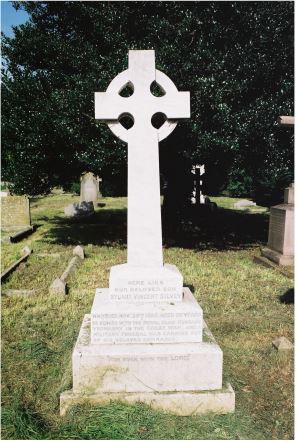1st/1st Battalion, Royal Gloucestershire Hussars

Stuart Vincent Silvey was born at Stonehouse, Gloucestershire in early 1894, the son of Joseph Frederick Silvey and his wife Amelia Emily. It is believed that he was their only child.
At the time of the 1911 Census, the family lived at Tivoli House, Haywards End, Stonehouse. Joseph Silvey was employed as an iron moulder, gas and oil engines at Dudbridge and Stuart was an apprentice to an iron monger business.
Unfortunately, no Army Service Record has survived for Stuart, however, the report of his funeral in the Gloucestershire Echo of 2 December 1920 states that he enlisted into the Gloucestershire Yeomanry (also known as the Royal Gloucestershire Hussars (RGH)) when war broke out. A Medal Rolls Index Card (MRIC) exists for him in the National Archives and this confirms that he first went abroad, to Egypt, on 29 September 1915.
It is possible that he saw service in Gallipoli, however, the 1/1st RGH were withdrawn on 31 October having suffered greatly from casualties and sickness, so possibly this is unlikely. In December 1915 the unit was back in Egypt and in early 1916 became part of the 5th Mounted Brigade, charged with the defence of the Suez Canal, against Turkish incursion.
On the night of 22 April 1916, the 5th Mounted Brigade was deployed in the Katia District, about 25 miles east of the Suez Canal in northern Sinai. Its job was to cover the construction of a railway which was being pushed east and had reached Romani and to reconnoitre and develop water supplies. Two squadrons of the Worcestershire Yeomanry were positioned at Oghratina, two squadrons of the Warwickshire Yeomanry, plus the remaining squadrons of the Worcestershires were preparing for an attack on the Turks at Bir el Hamish. The GRH had a squadron at Katia itself and another two at Romani.
Overnight a Turkish force of about 3600 men, led by a German officer, advanced on the British positions. At 4.30am on 23 April the Worcesters were surprised at Oghratina and overcome after a three hour fight. The Turks pressed on to Katia and at 8am attacked the squadron of the RGH. The RGH, reinforced by squadrons of the Worcesters from Bel el Harish, held out until about 3pm. Efforts by the RGH squadrons from Romani and Warwicks from Bir el Hamish, proved unsuccessful. The Turks took about 280 prisoners during these actions and it is believed that one of them was Private Silvey.
He was reported as ‘missing’ in the Gloucestershire Journal of 20 May 1916, along with many others from the RGH and it appears certain he was captured on 23 April. In the above funeral report, it states that after being taken prisoner he received such cruel treatment at the hands of the Turks ‘that his constitution was wrecked’.
Following the Armistice, he was repatriated and his MRIC states that he was dis-embodied on 8 March 1919 and evidently, he resumed his position as an assistant at the Stroud ironmongers of Messrs Smith & Lee.
In the middle of November 1920 he developed a severe cold and not in the best of health, following his three years’ incarceration, he developed pneumonia and died at home on 25 November, age 26. He was not married but was believed to have been engaged.
His funeral, on 2 December, was attended by many people and his pall bearers included four former prisoners of war comrades. Three volleys of shots were fired over his grave and a bugler sounded The Last Post. A stone cross now marks his grave in Stonehouse (St Cyr) Churchyard Extension and an inscription reads: He served with the Royal Gloucestershire Hussars Yeomanry in the Great War and a military funeral was carried out by his beloved comrades.
Researched by Graham Adams January 2019
